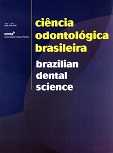Influência das soluções de glutaraldeído à 2% nas forças geradas pelos elásticos ortodônticos em cadeia
DOI:
https://doi.org/10.14295/bds.2008.v11i1.321Abstract
O objetivo deste estudo foi avaliar as alterações da força e inicial liberada pelos elásticos ortodônticos em cadeia em ambas as conformações, aberta e fechada, de três diferentes marcas comerciais (American Orthodontics, Unitek e Morelli), após imersão em duas diferentes soluções de glutaraldeído (Cidex e Anti-G Plus) para desinfecção (30 minutos) e para esterilização (10 horas). Os elásticos tiveram suas forças medidas em uma máquina de ensaios de tração (EMIC-DL 500 MF célula 1 Kgf). Os resultados foram gerados por um computador conectado à máquina de tração e foram submetidos a testes estatísticos (Wilcoxon signed rank test e Mann-Whitney rank sum test) com p < 0,05. Os resultados demonstraram que a imersão dos elásticos em cadeia nas soluções de glutaraldeído à 2% promove queda na liberação inicial da força, sendo em maior intensidade para o procedimento de esterilização. Não foram constatadas diferenças estatisticamente significativas entre as marcas Unitek e Morelli quando comparados os elásticos de cadeia aberta e fechada. Este fato não foi observado em relação aos elásticos da marca American Orthodontics. Concluiu-se que as soluções de glutaraldeído influenciam nas propriedades mecânicas dos elásticos ortodônticos em cadeia, sendo o aumento do tempo de imersão o fator principal na queda da liberação incial de força, porém, apesar de estatisticamente significativo, os resultados do grau de degradação da força elástica, em termos de valores absolutos, podem não ser importantes clinicamente, viabilizando assim, a esterilização química dos elásticos ortodônticos com a implementação de sua utilização no consultório ortodôntico.Downloads
Downloads
Published
How to Cite
Issue
Section
License
Brazilian Dental Science uses the Creative Commons (CC-BY 4.0) license, thus preserving the integrity of articles in an open access environment. The journal allows the author to retain publishing rights without restrictions.
=================




























